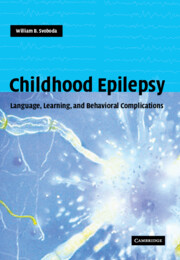Book contents
- Frontmatter
- Contents
- Preface
- Glossary
- 1 Looking ahead
- Part I Speech and language problems
- Part II Learning problems
- 12 Learning challenges
- 13 The development of learning
- 14 Learning difficulties
- 15 Learning problems with seizure types
- 16 Modifying factors
- 17 Transient cognitive impairments of epilepsy
- 18 Attention and alertness
- 19 Memory
- 20 Executive functioning
- 21 Academics
- 22 Antiepileptic medication effects
- 23 Effects of other therapies
- 24 Diagnosis
- 25 Gaining help
- 26 Frustrations of learning problems
- Part III Behavior problems
- Index
- References
13 - The development of learning
from Part II - Learning problems
Published online by Cambridge University Press: 26 October 2009
- Frontmatter
- Contents
- Preface
- Glossary
- 1 Looking ahead
- Part I Speech and language problems
- Part II Learning problems
- 12 Learning challenges
- 13 The development of learning
- 14 Learning difficulties
- 15 Learning problems with seizure types
- 16 Modifying factors
- 17 Transient cognitive impairments of epilepsy
- 18 Attention and alertness
- 19 Memory
- 20 Executive functioning
- 21 Academics
- 22 Antiepileptic medication effects
- 23 Effects of other therapies
- 24 Diagnosis
- 25 Gaining help
- 26 Frustrations of learning problems
- Part III Behavior problems
- Index
- References
Summary
The age of onset of the seizures is important as it may influence, inhibit, or impair cognitive processes developing at that time and thereafter. The clinical presentation of these effects relates to the seizure focus location but may be modified by the brain's ability to develop skills elsewhere.
Anatomy
The number of brain cells is estimated at more than 100 billion neurons. In utero, neurons develop at a rate of more than 250,000 per minute (Cowan, 1979). Each germinal neuron must not only migrate to its terminal destination, but also ultimately become connected to approximately 5000–15,000 other neurons (Cragg, 1975). Much of cell proliferation and migration is prenatal, while much of the development of axonal and dendritic connections is postnatal, alternating with pruning in spurts, with major cycles peaking in the toddler, in the prepubertal childhood period, and in early puberty. The left hemisphere cycles ahead of the right hemisphere by a year or two, which may relate to language dominance over non-language functions. The cycling varies somewhat in different parts of the brain (Thatcher, 1997). The timing of seizure insult sequelae may relate to the time of occurrence in the cycle.
Dendritic growth is the main avenue of learning development. The neurocircuity develops rapidly to be most complex at around two to three years of age. Thereafter, the cyclic pruning away of what is not used or needed occurs so that the circuitry is far less complex by adolescence.
- Type
- Chapter
- Information
- Childhood EpilepsyLanguage, Learning and Behavioural Complications, pp. 171 - 185Publisher: Cambridge University PressPrint publication year: 2004



